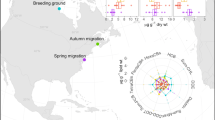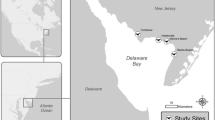Abstract
The San Francisco Bay estuary isused by over one million shorebirds during springmigration and is home to several hundred thousandduring the winter. Most shorebird use occurs in thesouthern reach of the estuary (South Bay). Thereduced water circulation and discharge fromindustrial sources in the South Bay are responsiblefor the highest levels of some trace elements in theestuary. Wintering shorebirds have been found to havestrong site fidelity to areas as small as a fewkilometers in the South Bay, which may increase theirexposure to contaminants near local point sources. Inaddition, different shorebird species foraging at thesame site have been shown to have differentcontaminant burdens. Thus, our objectives were totest whether contaminant burdens differed by species,or whether contaminant burdens differed in shorebirdscollected at adjacent sites. We examined thecontaminant profiles of two species of shorebirds,long-billed dowitchers (Limnodromus scolopaceus)and western sandpipers (Calidris mauri) thatforage together at two sites, Hayward and Newark,separated by 8 km in the South Bay. We usedmultivariate analysis of variance tests to compare thecomposition of 14 elemental analytes in their livertissues and estimated their molar ratios of Hg and Se. Composite samples were used for contaminant analysesbecause of the small body size of the shorebirds. Seven elemental analytes (Ag, Ba, Be, Cr, Ni, Pb, V)were below detection limits in a majority of thesamples so statistical analyses were precluded. Inthe measurable analytes (As, Cd, Cu, Hg, Mn, Se, Zn),we found no significant intra-site differences ofcontaminant profiles for the two species. We pooledthe samples to examine inter-site differences andfound significant differences in contaminant profilesbetween shorebirds at the neighboring sites (P = 0.03). Shorebirds at Newark had higher (P < 0.05) concentrations of As, Cd, and Se than those at Hayward. Dowitchers at Newark had concentrations of Hg and Se which were highly correlated (P < 0.003) in a mean molar ratio of 1:19, similar tothat reported in other birds. In the larger dowitcherspecies, we also examined exposure to 20organochlorine compounds. Organic analyses showedthat the dowitchers had been exposed to DDE, PCBs,dieldrin and trans-nonachlor, but with no significantdifferences in concentrations between Hayward andNewark (P > 0.05).
Similar content being viewed by others
REFERENCES
Anonymous a: ‘Determination of organochlorine pesticides and polychlorinated biphenyls (PCBs) in biological tissues’, Method MP-FWST-MA, Hazleton Laboratories America, Inc., Madison, Wisconsin.
Anonymous b: ‘Determination of organochlorine pesticides and polychlorinated biphenyls (PCBs) in soils and sediments’, Method MP-FWSS-MA, Hazleton Laboratories America, Inc., Madison, Wisconsin.
Barbosa, A. and Moreno, E.: 1999, ‘Evolution of foraging strategies in shorebirds: an ecomorphological approach’, Auk 116, 712–725.
Barker, H. R. and Barker, B. M.: 1984, Multivariate Analysis of Variance (MANOVA), University of Alabama Press, University.
Belliveau, M.: 1987, ‘Toxic hot spots in San Francisco Bay’, CBE Report 87686, Citizens for a Better Environment, San Francisco.
Blomqvist, S., Frank, A. and Petersson, L. R.: 1987, ‘Metals in liver and kidney tissues of autumnmigrating dunlin Calidris alpina and curlew Sandpiper Calidris ferruginea staging at the Baltic Sea’, Mar. Ecol. Progress Series 35, 1–13.
Burger, J. and Gochfeld, M.: 1995, ‘Growth and behavioral effects of early postnatal chromium and manganese exposure in herring gull (Larus arentatus) chicks’, Pharmacol. Biochem. Behav. 50, 607–612.
Burger, J., Seyboldt, S., Morganstein, N. and Clark, K.: 1993, ‘Heavy metals and selenium in feathers of three shorebird species from Delaware Bay’, Environ. Monit. Assess. 28, 189–198.
Clarke, J. U.: 1998, ‘Evaluation of censored data methods to allow statistical comparisons among very small samples with below detection limit observations’, Environ. Sci. Technol. 32, 177–183.
Custer, T. W. and Hohman, W. L.: 1984, ‘Trace elements in canvasbacks (Aythya valisineria) wintering in Louisiana, U.S.A., 1987–1988’, Environ. Poll. 84, 253–259.
Custer, T. W. and Myers, J. P.: 1990, ‘Organochlorines, mercury, and selenium in wintering shorebirds from Washington and California’, Calif. Fish and Game 76, 118–125.
Davis, C. A. and Smith, L. M.: 1998, ‘Ecology and management of migrant shorebirds in the Playa Lakes region of Texas’, Wildlife Monographs 140, 1–45.
Eisler, R.: 1988, ‘Arsenic hazards to fish, wildlife, and invertebrates: A synoptic review’, U.S. Fish and Wildlife Svc. Biol. Rep. 85(1.12).
Eisler, R.: 1993, ‘Zinc hazards to fish, wildlife, and invertebrates: A synoptic review’, U.S. Fish and Wildlife Svc. Biol. Rep. 10.
Elliott, J. E., Scheuhammer, A. M., Leighton, F. A. and Pearce, P. A.: 1992, ‘Heavy metal and metallothionein concentrations in Atlantic Canadian seabirds’, Arch. Enviro. Contam. Toxicol. 22, 63–73.
Environmental Protection Agency: 1986a, ‘Test methods for evaluating solid waste – physical/ chemical methods’, EPA publication no. SW-846. Method 3540, Office of Solid Waste and Emergency Response, Washington, D.C.
Environmental Protection Agency: 1986b, ‘Test methods for evaluating solid waste – physical/ chemical methods’, EPA publication no. SW-846. Method 3550, Office of Solid Waste and Emergency Response, Washington, D.C.
Fimreite, N.: 1971, ‘Effects of dietary methylmercury on ring-necked pheasants’, Can. Wildl. Serv. Occ. Pap. 9.
Gilbert, R. O.: 1987, Statistical Methods for Environmental Pollution Monitoring, Van Nostrand Reinhold, New York.
Hartman. R. H., Matrone, G. and Wise, G. H.: 1955, ‘Effect of high dietary manganese on hemoglobin formation’, J. Nutrition 57, 429–439.
Harvey, T. E, Miller, K. J., Hothem, R. L., Rauzon, M. J., Page, G.W. and Keck, R. A.: 1992, ‘Status and Trends Report on Wildlife of the San Francisco Estuary’, San Francisco Estuary Project, San Francisco.
Heinz, G. H.: 1979, ‘Methylmercury: Reproductive and behavioral effects on three generations of mallard ducks’, J. Wildl. Manage. 43, 394–401.
Heinz, G. H., Pendleton, G.W., Krynitsky, A. J. and Bold, L. G.: 1990, ‘Selenium accumulation and elimination in mallards’, Arch. Environ. Contam. Toxicol. 19, 374–379.
Heinz, G. H. and Hoffman, D. J.: 1998, ‘Methylmercury chloride and selenomethionine interactions on health and reproduction in mallards’, Environ. Toxicol. Chem. 17, 139–145.
Hoffman, D. J., Heinz, G. H., LeCaptain, L. J. and Bunck, C. M.: 1991, ‘Subchronic hepatotoxicity of selenomethionine ingestion in mallard ducks’, J. Toxicol. and Environ. Health 32, 449–464.
Hothem, R. L., Lonzarich, D. G., Takekawa, J. E. and Ohlendorf, H. M.: 1998, ‘Contaminants in wintering canvasbacks and scaups from San Francisco Bay, California’, Environ. Monit. Assess. 50, 67–84.
Hui, C. A.: 1998, ‘Metal and trace element burdens in two shorebird species at two sympatric wintering sites in southern California’, Environ. Monit. Assess. 50, 233–247.
Hutton, M.: 1981, ‘Accumulation of heavy metals and selenium in three seabird species from the United Kingdom’, Environ. Poll. 26A, 129–145.
Johns, C. and Luoma, S. N.: 1990, ‘Arsenic in benthic bivalves of San Francisco Bay and the Sacramento/San Joaquin River Delta’, Sci. Total Environ. 97/98, 673–684.
Kay, J.: 1991, ‘Mercury levels may rise in bay’, San Francisco Examiner, pg. B-1. Nov. 17.
Koeman, J. H., Peters, W. H. M., Koudstaal-Hol, C. H. M., Tjioe, P. S. and De Goeij, J. J. M.: 1973, ‘Mercury-selenium correlations in marine mammals’, Nature 245, 385–386.
Laskey, J. W. and Edens, F. W.: 1985, ‘Effects of chronic high-level manganese exposure on male behavior in the Japanese quail (Coturnix coturnix japonica)’, Poultry Sci. 64, 579–584.
Leonzio, C., Fossi, C. and Focardi, S.: 1986, ‘Heavy metals and selenium variation in a migratory bird wintering in a mercury-polluted lagoon’, Bull. Environ. Contam. Toxicol. 37, 219–225.
Lincer, J. L.: 1975, ‘DDE-induced eggshell-thinning in the American kestrel: A comparison of the field situation and laboratory results’, J. Appl. Ecol. 12, 781–793.
Luoma, S. N. and Cain, D. J.: 1979, ‘Fluctuations of Copper, Zinc, and Silver in Tellenid Clams as Related to Freshwater Discharge – South San Francisco Bay’, in: T. J. Conomos, (ed.), San Francisco Bay: The Urbanized Estuary, Pacific Div. Am. Assoc. Adv. Sci., San Francisco, pp. 231–246.
McLane, M. A. R. and Hall, L. C.: 1972, ‘DDE thins screech owl eggshells’, Bull. Environ. Contam. Toxicol. 8, 65–68.
Meiri, V. and Rahamimoff, R.: 1972, ‘Neuromuscular transmissions: inhibition by manganese ions’, Science 1976, 308–309.
Michot, T. C., Custer, T. W., Nault, A. J. and Mitchell, C. A.: 1994, ‘Environmental contaminants in redheads wintering in coastal Louisiana and Texas’, Arch. Enviro. Contam. Toxicol. 26, 425–434.
Miles, A. K. and Ohlendorf, H. M.: 1993, ‘Environmental contaminants in canvasbacks wintering on San Francisco Bay, California’, Calif. Fish and Game 79, 28–38.
Möller, G.: 1996, ‘Biogeochemical interactions affecting hepatic trace element levels in aquatic birds’, Environ. Toxicol. Chem. 15, 1025–1033.
Myers, J. P., Connors, P. G. and Pitelka, F. A.: 1979, ‘Territoriality in non-breeding shorebirds’, Studies in Avian Biology 2, 231–246.
Ohlendorf, H. M., Lowe, R. W., Kelly, P. R. and Harvey, T. E.: 1986, ‘Selenium and heavy metals in San Francisco Bay diving ducks’, J. Wildl. Manage. 50, 64–71.
Ohlendorf, H. M., Marois, K. C., Lowe, R. W., Harvey, T. E. and Kelly, P. R.: 1991, ‘Trace elements and organochlorines in surf scoters from San Francisco Bay, 1985’, Environ. Monitor. Assess. 18, 105–122.
Ohlendorf, H. M. and Miller, M. R.: 1984, ‘Organochlorine contaminants in California waterfowl’, J. Wildl. Manage. 48, 867–877.
Page, G.W. and Fearis, B.: 1971, ‘Sexing western sandpipers by bill length’, Bird Banding, 4, 82–88.
Page, G. W. Stenzel, L. E. and Kjelmyr, J. E.: 1999, ‘Overview of shorebird abundance and distribution in wetlands of the Pacific coast of the contiguous United States’, Condor, 101, 461–471.
Parslow, J. L. F., Thomas, G. J. and Williams, T. D.: 1982, ‘Heavy metals in the livers of waterfowl from the Ouse Washes, England’, Environ. Poll. 29, 317–327.
Paulson, D.: 1993, Shorebirds of the Pacific Northwest, Univ. Wash, Seattle, pp. 248–328.
Prater, A. J., Marchant, J. H. and Vourinen, J.: 1977, Guide to the Identification and Aging of Holarctic Waders. British Trust for Ornithology, Tring.
Scheuhammer, A. M.: 1987, ‘The chronic toxicity of aluminum, cadmium, mercury, and lead in birds: A review’, Environ. Poll. 46, 263–295.
Shukla, G. S. and Singhal, R. L.: 1984, ‘The present status of biological effects of toxic metals in the environment: lead, cadmium, and manganese’, Can. J. Pharmacol. 62, 1015–1031.
Struger, J., Elliot, J. W. and Weseloh, D. V.: 1987, ‘Metals and essential elements in herring gulls from the Great Lakes, 1983’, J. Great Lakes Res. 13, 43–55.
Symonds, F. L. and Langslow, D. R.: 1984, ‘Movements of wintering shorebirds within the Firth of Forth: Species differences in usage of an intertidal complex’, Biol. Conserv. 28, 187–215.
Takekawa, J. Y. and Warnock, N.: 2000, ‘Long-Billed Dowitcher (Limnodromus scolopaceus)’, in: A. Poole and F. Gill (eds.), The Birds of North America, The Academy of Natural Sciences, Philadelphia, and The American Ornithologists’ Union, Washington, D.C. (in press).
Warnock, S. E. G. and Takekawa, J. Y.: 1995, ‘Habitat preferences of wintering shorebirds in a temporally changing environment: western sandpipers in the San Francisco Bay estuary’, Auk 112, 920–930.
Warnock, S. E. G. and Takekawa, J. Y.: 1996, ‘Wintering site fidelity and movement patterns of western sandpipers (Calidris mauri) in the San Francisco Bay estuary’, Ibis 138, 160–167.
Warren, R. J., Wallace, B. M. and Bush, P. B.: 1990, ‘Trace elements in migrating blue-winged teal: Seasonal-, sex-and age-class variations’, Environ. Toxicol. Chem. 9, 521–528.
Author information
Authors and Affiliations
Corresponding author
Rights and permissions
About this article
Cite this article
Hui, C.A., Takekawa, J.Y. & Warnock, S.E. Contaminant Profiles of Two Species of Shorebirds Foraging Together at Two Neighboring Sites in South San Francisco Bay, California. Environ Monit Assess 71, 107–121 (2001). https://doi.org/10.1023/A:1017526130205
Issue Date:
DOI: https://doi.org/10.1023/A:1017526130205




